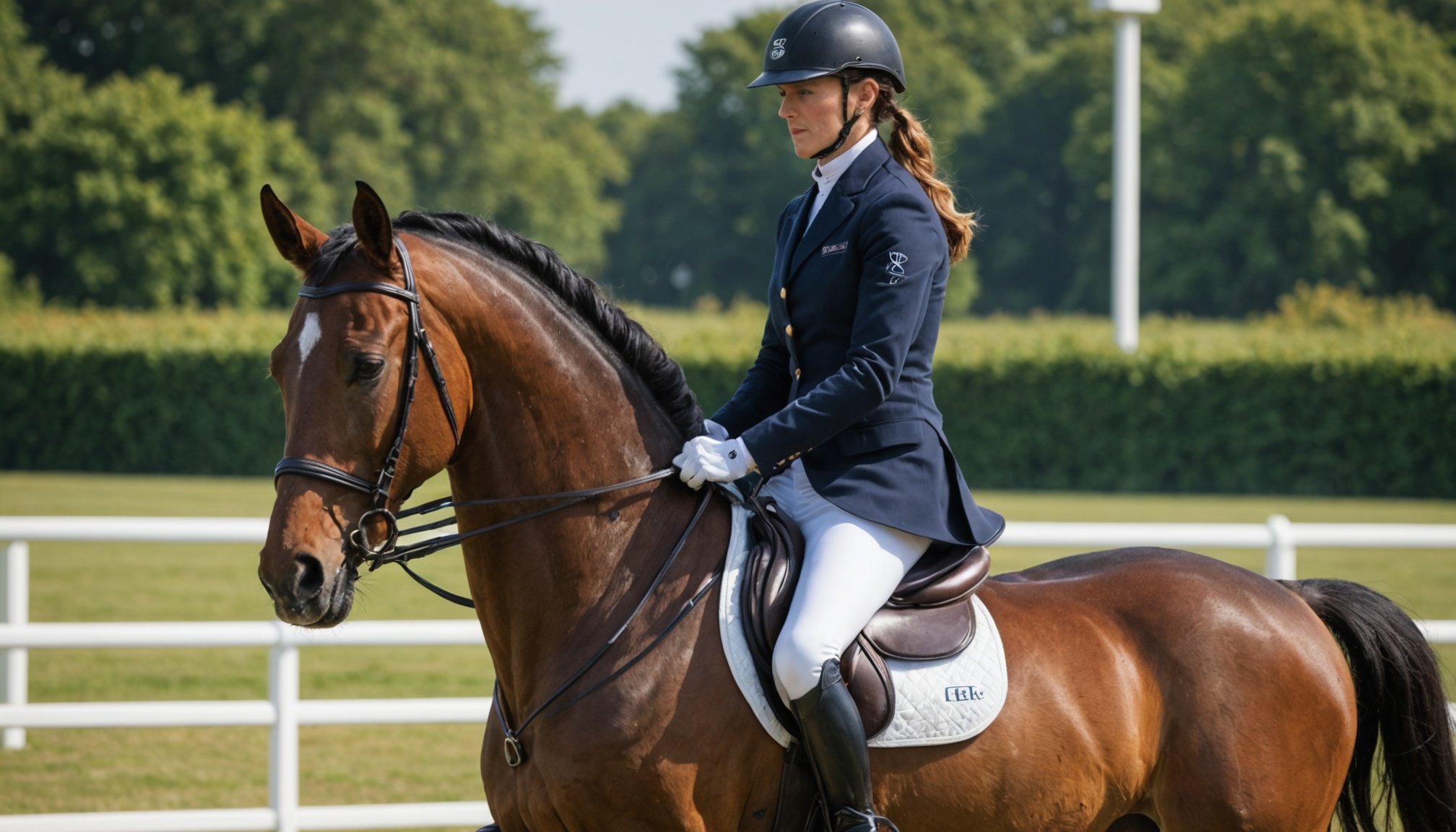Understanding the Importance of Focus in Dressage Competitions
Maintaining robust focus techniques is crucial for achieving success in dressage competitions. Dressage performance hinges not only on physical prowess but also on the competitor’s ability to concentrate under pressure. A well-honed competition mindset can be the differentiating factor in performance outcomes.
Distractions and external pressure can greatly undermine performance. Whether it’s unexpected noises, fluctuating competition schedules, or personal expectations, these distractions can disrupt the mental state needed for optimal concentration. Thus, developing effective focus techniques becomes essential not just for managing distractions, but also for transforming pressure into a source of power.
The benefits of enhanced focus for competitors are numerous. When focus is amplified, riders are better able to synchronise their movements with the horse’s rhythm, leading to seamless transitions and superior routines. The heightened sense of awareness ensures that every movement is deliberate and graceful, showcasing the intricate skills of both horse and rider.
In summary, focus techniques form a critical foundation for all elements of dressage performance. Cultivating a resilient competition mindset allows athletes to navigate the pressures of competitive environments deftly and maintain peak performance levels even amidst challenges.
Also to discover : Elevate your fencing footwork: discover the key techniques for boosting speed and agility
Breathing Techniques for Enhanced Focus
Breathing exercises can play a vital role in managing the pressure of dressage competitions. By incorporating specific breathing techniques, competitors can significantly enhance their relaxation methods and focus.
Diaphragmatic Breathing
This method involves consciously inhaling deeply, allowing the diaphragm rather than the chest to expand. Begin by placing one hand on your abdomen. As you inhale through your nose, feel your abdomen rise, then exhale slowly through your mouth. These steps lower stress levels and help in maintaining pressure management by calming nerves. Highly applicable in high-stakes scenarios, it steadies both body and mind.
4-7-8 Breathing Technique
This technique aims for deeper mental clarity. Inhale for four counts, hold the breath for seven, and exhale completely for eight counts. Competitors often report improved concentration, as the method shifts the focus inward, regulating physiological responses to stress. Regular practice of this technique can empower athletes to access enhanced performance levels during competitions.
Timing Breathing with Movements
Integrating breath with each motion during a routine can refine control and composure. For instance, coordinate inhalations with upward body movements and exhalations with downward shifts. This synchronisation fosters a fluid, focused performance. Competitors can experiment with varied routines to better align with their unique riding posture.
Visualization Techniques to Boost Performance
Developing robust visualization methods can significantly enhance dressage performance. By employing mental rehearsal, competitors can anticipate and execute movements with greater precision. These techniques bolster confidence and prepare athletes mentally for competitive settings.
Imagining Success
Visualizing an ideal performance involves creating a detailed mental image of an event in which every gesture and motion is executed flawlessly. Competitors are encouraged to engage multiple senses during this process, picturing the sight, sound, and feel of their routine. Crafting a vivid scenario helps lock focus and intention. Routine practice of these visualization exercises is crucial. Competitors should aim to incorporate them into their daily regimen, dedicating specific time slots for concentrated mental rehearsal.
Visualizing the Course
Like a map, mentally charting out the dressage test allows riders to anticipate potential obstacles or challenging segments. Effective strategies include breaking down the course into manageable sections and focusing visualization efforts on overcoming these specific hurdles. Incorporating this practice into training empowers riders to remain mentally prepared and adaptable when navigating the actual course under pressure.
Guided Imagery Exercises
Guided imagery resources can lead to profound improvements in focus levels. Various resources or self-created sessions can aid athletes in honing their focus. Integrating these exercises before competitions may prevent anxiety and enhance overall performance.
Mindfulness Practices for Competitors
Incorporating mindfulness techniques into dressage training can significantly enhance mental resilience and improve focus. Learning to maintain presence and awareness in high-pressure environments is key for competitors striving for peak performance.
Mindfulness Meditation
Simple meditation practices can bolster increased awareness during competitions. Techniques include focusing on breathing or observing bodily sensations, fostering a calming sense of presence. These exercises lower anxiety, making them invaluable in high-pressure competition scenarios. Numerous apps and resources are available to guide athletes through effective meditation practices.
Grounding Techniques
Staying present and focused during competitions is essential. Grounding techniques like deep breathing or observing immediate surroundings can clear the mind of distractions. Personal accounts from experienced competitors underscore the effectiveness of these strategies in maintaining concentration.
Incorporating Mindfulness into Training
Embedding mindfulness into daily training fosters resilience. Competitors are encouraged to establish goal-setting practices, reflecting on their outcomes to enhance focus. These habits bridge training environments to competitive scenarios, proving indispensable during high-stakes performances. Developing such habits ensures athletes can thrive even amidst the challenges of dressage competitions.
Strategies for Managing Competition Nerves
Navigating competition nerves is critical for any athlete aiming for peak performance readiness. Understanding the root causes of competition anxiety can empower competitors to manage their responses effectively. Often, these nerves stem from fear of failure, high expectations, or lack of familiarity with competitive environments.
Transforming nerves into positive energy can be remarkably beneficial. Techniques include reframing thoughts to view nerves as signs of readiness and enthusiasm. This perspective shift fosters an invigorated mindset, turning potential roadblocks into motivations. Additionally, regulating physiological responses, such as increased heart rate, is vital. Techniques like controlled breathing and positive self-talk can regulate adrenaline spikes, improving overall focus.
Experts recommend visualization and mindfulness practices to prepare mentally for competition. These strategies enable athletes to simulate pressure scenarios, enhancing their ability to remain centred during actual events.
The champion’s mindset views nerves not as an enemy but as an ally—evidence of the body’s preparedness for competition. By harnessing this energy, athletes can enhance their confidence and ensure they step into the arena feeling invigorated, poised, and ready to achieve their best performance.
Building Mental Resilience
Strengthening mental resilience is essential in withstanding the pressures of dressage competitions. This involves developing coping strategies to handle setbacks and challenges efficiently.
Cognitive Restructuring
Cognitive restructuring helps shift negative thought patterns. By actively altering perceptions of failure or inadequacy, competitors can build a more positive competition outlook. For instance, reinterpreting a less-than-perfect performance as a learning experience rather than a setback can enhance one’s mindset. Real-life examples abound from high-performing athletes who have used this technique to maintain confidence and focus, even when under immense pressure.
Setting Incremental Goals
Incremental goals play a significant role in resilience-building. Setting smaller, attainable objectives within the broader scope of competitions allows competitors to track progress and build confidence gradually. This approach aids in maintaining motivation and offers clear benchmarks for improvement. Competitors often report that these short-term goals have been instrumental in developing a determined mindset and consistent performance.
Learning from Setbacks
Embracing setbacks as learning opportunities is crucial. By analysing failures, competitors gain insights into areas of improvement, transforming challenges into growth. Personal anecdotes demonstrate how athletes have used setbacks to refine skills and strategies, ultimately enhancing their competitive edge. Cultivating a resilient mindset not only aids in immediate recovery but fosters long-term success in competitions.





